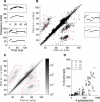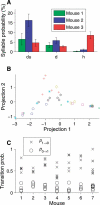Ultrasonic songs of male mice
- PMID: 16248680
- PMCID: PMC1275525
- DOI: 10.1371/journal.pbio.0030386
Ultrasonic songs of male mice
Abstract
Previously it was shown that male mice, when they encounter female mice or their pheromones, emit ultrasonic vocalizations with frequencies ranging over 30-110 kHz. Here, we show that these vocalizations have the characteristics of song, consisting of several different syllable types, whose temporal sequencing includes the utterance of repeated phrases. Individual males produce songs with characteristic syllabic and temporal structure. This study provides a quantitative initial description of male mouse songs, and opens the possibility of studying song production and perception in an established genetic model organism.
Figures








References
-
- Simmons AM, Popper AN, Fay RR, editors. Acoustic communication. Volume 16, Springer handbook of auditory research. New York: Springer; 2003. 404 pp.
-
- Marler P, Slabbekoorn H, editors. Nature's music: The science of birdsong. Boston: Elsevier; 2004. 513 pp.
-
- Payne RS, McVay S. Songs of humpback whales. Science. 1971;173:585–597. - PubMed
-
- Behr O, von Helversen O. Bat serenades—Complex courtship songs of the sac-winged bat Saccopteryx bilineata . Behav Ecol Sociobiol. 2004;56:106–115.
-
- Whitney G, Nyby J. Sound communication among adults. In: Willott JR, editor. The auditory psychobiology of the mouse. Springfield (Illinois): C. C. Thomas; 1983. pp. 98–129.
Publication types
MeSH terms
Grants and funding
LinkOut - more resources
Full Text Sources

